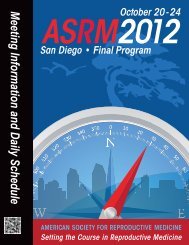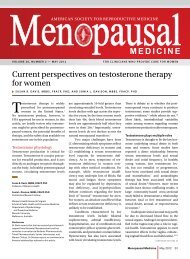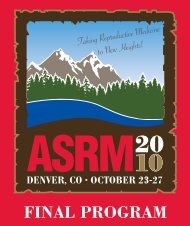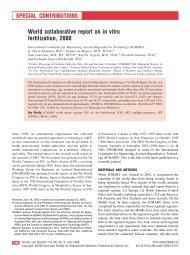scientific program • symposia - American Society for Reproductive ...
scientific program • symposia - American Society for Reproductive ...
scientific program • symposia - American Society for Reproductive ...
You also want an ePaper? Increase the reach of your titles
YUMPU automatically turns print PDFs into web optimized ePapers that Google loves.
SCIENTIFIC PROGRAM <strong>•</strong> INTERACTIVE SESSIONS<br />
Monday, October 17, 2011 1:15 pm – 2:15 pm<br />
Interactive Session<br />
ANTICHLAMYDIAL ANTIBODY SCREENING OF THE INFERTILITY<br />
PATIENT<br />
Presented by the <strong>Reproductive</strong> Immunology Special Interest Group<br />
Danny J. Schust, M.D. (Chair)<br />
University of Missouri School of Medicine<br />
Guangming Zhong, M.D., Ph.D.<br />
University of Texas Health Science Center<br />
Jared C. Robins, M.D.<br />
The Warren Alpert Medical School of Brown University<br />
Needs Assessment and Description<br />
Chlamydia trachomatis is the most prevalent bacterial<br />
sexually transmitted infection, and 20% of women with C.<br />
trachomatis get pelvic inflammatory disease (PID). The risk<br />
<strong>for</strong> tubal infertility doubles with each subsequent episode<br />
of PID. Women infected with C. trachomatis who remain<br />
asymptomatic may still suffer the fertility consequences of<br />
infection.<br />
The gold standards used to test <strong>for</strong> tubal factor infertility<br />
continue to be laparoscopy or hysterosalpingography<br />
(HSG). Interest in C. trachomatis antibody testing has been<br />
reinvigorated by improved testing specificity and sensitivity,<br />
and the push by patients, providers and reimbursement<br />
sources <strong>for</strong> inexpensive and noninvasive testing and<br />
treatments <strong>for</strong> fertility patients.<br />
During this interactive session, advances in C. trachomatis<br />
antibody testing and its relevance to male and female<br />
fertility will be reviewed. The utility of a variety of<br />
available and upcoming tests and compare their value<br />
to laparoscopy and/or hysterosalpingography will be<br />
discussed.<br />
Room 224 C/D<br />
85<br />
Learning Objectives<br />
At the conclusion of this session, participants should be able<br />
to:<br />
1. List the advantages and disadvantages of antichlamydial<br />
antibody testing <strong>for</strong> male and female patients with<br />
impaired fertility.<br />
2. Discuss the role of heat shock protein cross reactivity in<br />
chlamydia-related infertility and pregnancy wastage.<br />
ACGME COMPETENCY<br />
Medical Knowledge<br />
Patient Care<br />
Monday, October 17, 2011 1:15 pm – 2:15 pm<br />
Interactive Session<br />
EMBRYO SELECTION: GENOMICS, METABOLOMICS AND<br />
MORPHOLOGICAL ASSESSMENT<br />
Presented by the Latin <strong>American</strong> Association <strong>for</strong> <strong>Reproductive</strong> Medicine<br />
(ALMER)<br />
Carlos E. Sueldo, M.D. (Chair)<br />
University of Cali<strong>for</strong>nia San Francisco<br />
Mandy Katz-Jaffe, Ph.D.<br />
Colorado Center <strong>for</strong> <strong>Reproductive</strong> Medicine<br />
Denny Sakkas, Ph.D.<br />
Yale University School of Medicine<br />
Needs Assessment and Description<br />
Traditionally, embryo selection prior to embryo transfer was<br />
based on morphological assessment. More recently, the role<br />
of genomics and metabolomics were introduced as very<br />
effective alternatives to better select high quality embryos<br />
<strong>for</strong> transfer. There is a need to identify the place of these<br />
newer techniques in ART, and also how they compare to the<br />
more traditional embryo selection process.<br />
Learning Objectives<br />
At the conclusion of this interactive session, participants<br />
should be able to:<br />
1. Outline the present status of genomics and metabolomics<br />
in ART.<br />
2. Summarize the advantages and disadvantages of<br />
morphological embryo selection vs. the newer<br />
techniques.<br />
Room F 5<br />
TEST QUESTION:<br />
After participating in this session, I will do the following in my<br />
practice:<br />
A. Per<strong>for</strong>m only diagnostic laparoscopy and tubal lavage to<br />
evaluate fallopian tubal patency in new fertility patients.<br />
B. Per<strong>for</strong>m only hystersalpingography (HSG) to establish<br />
fallopian tubal patency in new fertility patients.<br />
C. Consider anti-chlamydial antibody testing prior to more<br />
invasive testing <strong>for</strong> fallopian tubal patency in new fertility<br />
patients.<br />
D. Per<strong>for</strong>m only saline infusion sonohysterography (SIS) to<br />
evaluate fallopian tubal patency in new fertility patients.<br />
E. Not investigate fallopian tubal patency in new fertility<br />
patients.<br />
F. Not applicable to my area of practice.<br />
ACGME COMPETENCY<br />
Medical Knowledge<br />
TEST QUESTION:<br />
A 35-year-old infertile female has had 3 consecutive<br />
miscarriages, all with documented abnormal karyotype. In a<br />
current IVF cycle, she has 5 expanded blastocysts, all displaying<br />
similar morphology. After participating in this session, to optimize<br />
her chances of avoiding a subsequent miscarriage, in my<br />
practice I will use the following diagnostic technique <strong>for</strong> embryo<br />
selection <strong>for</strong> transfer:<br />
A. Metabolomics<br />
B. Proteomics<br />
C. 23- pair chromosome aneuploidy screening<br />
D. Glucose testing<br />
E. Gene defect screening<br />
F. Not applicable to my area of practice.








